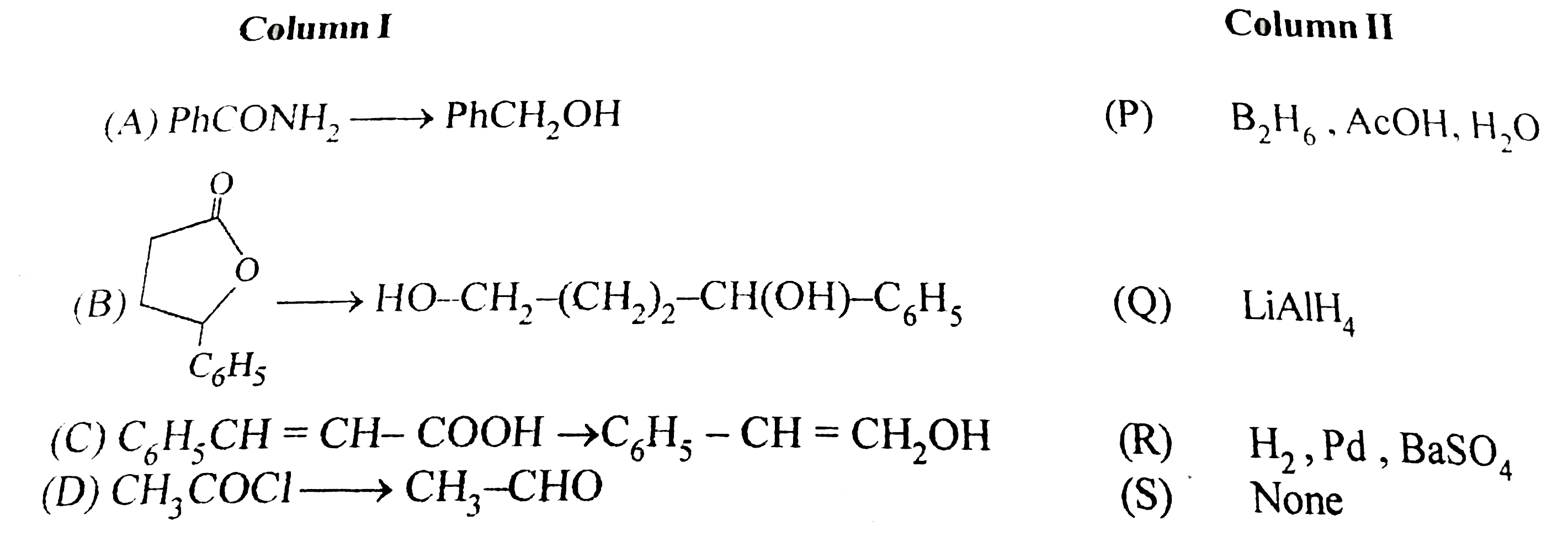Complete Solutions to Exercise 2 of chapter CARBOXYLIC ACID DERIVATIVES of Class 12 book with complete answers and questions
| Class 12 | CHEMISTRY |
| Chapter | CARBOXYLIC ACID DERIVATIVES |
| BANSAL | Exercise 2 |
| Number Of Questions | 39 |
| Academic Year | 2023-24 |

An unknown compound having molecular formula `C_(8)H_(4)O_(2)Cl_(2)` can give following set of reactions. Your Answer 1 to 4 on basic of this reaction sequence.
What could be the structure of A:
View Solution
An unknown compound having molecular formula `C_(8)H_(4)O_(2)Cl_(2)` can give following set of reactions. Your Answer 1 to 4 on basic of this reaction sequence.
What could be the structure of B:
View Solution
An unknown compound having molecular formula `C_(8)H_(4)O_(2)Cl_(2)` can give following set of reactions. Your Answer 1 to 4 on basic of this reaction sequence.
Structure of D is (Stable one)
View Solution
An unknown compound having molecular formula `C_(8)H_(4)O_(2)Cl_(2)` can give following set of reactions. Your Answer 1 to 4 on basic of this reaction sequence.
Structure of C is
View Solution
Ozonolysis of a compound Agathene dicarboxylic acid gives following compounds:
On complete reduction by `Na-EtOH`. Agathene dicarboxylic acid give hydrocarbon `C_(20)H_(38)` which have 5 chiral carbon it.
Q. The structure of Agathene dicarboxylic acid is-
View Solution
Ozonolysis of a compound Agathene dicarboxylic acid gives following compounds:
On complete reduction by `Na-EtOH`, Agathene dicarboxylic acid give hydrocarbon `C_(20)H_(38)` which have 5 chiral carbon in it.
Q. How many chiral carbon are present in Agathene dicarboxylic acid:
View Solution
Ozonolysis of a compound Agathene dicarboxylic acid gives following compounds:
On complete reduction by `Na-EtOH`. Agathene dicarboxylic acid give hydrocarbon `C_(20)H_(38)` which have 5 chiral carbon it.
Q. Total stereoisomers possible for agathene dicarboxylic acid are:
View Solution
Ozonolysis of a compound Agathene dicarboxylic acid gives following compounds:
On complete reduction by `Na-EtOH`. Agathene dicarboxylic acid give hydrocarbon `C_(20)H_(38)` which have 5 chiral carbon it.
Q. Structure of product formed when agathene dicarboxylic acid is heated with soda lime is:
View Solution
Ozonolysis of a compound Agathene dicarboxylic acid gives following compounds:
On complete reduction by `Na-EtOH`. Agathene dicarboxylic acid give hydrocarbon `C_(20)H_(38)` which have 5 chiral carbon it.
Q. True statement about agathene dicarboxylic acid is:
View Solution
Product C and D are
View Solution
Mechanism for hydrolysis of A will be
View Solution
F is.
View Solution
Mechanism of formation of A and B is
View Solution
Select the true statement
View Solution
Best method out of the given to prepare B is
View Solution
Statement-I: is optically inactive, it is taken in a glass container and plane polarized light (PPL) is passed through it after heating it for several minutes The PPL shows significant optical rotation.
Statement-II: Like `beta`-keto acid, gem dicarboxylic acid eliminates `CO_(2)` on heating.
View SolutionStatement-I: `Me_(3)C-overset(O)overset(||)(C)-OH+overset(18)(MeOH)overset(conc.H_(2)SO_(4))toMe_(3)C-overset(O)overset(||)(C)-overset(18)(OM)e` (Major)
Statement-II: During esterification removed water molecule contains H of alcohol and OH of carboxylic acid.
View Solution
Statement-I:
Statement-II: 2-butene is more stable than -2butene as it is having more `alpha-H`.
View SolutionWhich of the following will liberate `CO_(2)` on reaction with `NaHCO_(3)`
View SolutionRCOOR' can be prepared by:
View SolutionWhich of the following compounds will give acetic acid with `KMnO_(4)//H^(o+)//Delta`:
View SolutionAcetic acid can be used for the preparation of
View SolutionWhich of the following will form acetyl chloride with `PCl_(5)`?
View SolutionConsider the following reaction:
`CH_(3)-overset(O)overset(||)(C)-OH+CH_(3)-OH overset(H^(o+))hArrCH_(3)-overset(O)overset(||)(C)-O-CH_(3)+HOH`
True about the reaction is:
View SolutionWhich one of the following compounds will give HVZ reaction?
View SolutionSodium salt of which one of the monobasic acids on electrolysis does not give hydrocarbon:
View SolutionWhich one of the following acids undergoes decarboxylation on strong heating:
View SolutionWhich one of the following compounds is least reactive with water?
View SolutionAcetic anhydride is used as:
View SolutionIn the given reaction
`R-overset(O)overset(||)(C)-OHoverset([X])toR-overset(O)overset(||)(C)-O-CH_(3)`
[X] will be:
View SolutionWhich of the followig gives silver mirror test?
View SolutionWhich compound will liberate `CO_(2)` from `NaHCO_(3)` ?
View SolutionWhich of the following compound can be produced if 1-propane amine is treated with `NaNO_(2)` and HCl
View SolutionHOFFMANN BROMAMIDE DEGRADATION REACTION
View Solution`CH_(3)-overset(O)overset(||)(C)-O-CH_(2)-CH_(3)overset(Hoverset(18)(O)H//H^(o+))tohArr"Ethanoic acid"+"Ethanol"`
Isotopic oxygen of water will be present with
View SolutionMatch the column-
`{:(underset("organic compounds oxidised by "KIO_(4))"Column I",underset("products of "KIO_(4)" oxidation")"Column II"),((A)." "CH_(3)COCHO,(P)" "PhCH=O+HCOOH),((B)." 1,2k-cyclohexane dione",(Q)." "CH_(3)CH_(2)CHO+HOOC CH_(3)),((C)." "PhCH(OH)CHO,(R)." "HOOC(CH_(2))_(4)COOH),((D)." "CH_(3)CH_(2)CH(OH)COCH_(3),(S)." "CH_(3)COOH+HCOOH):}`
View SolutionMatch the column
`{:("Column I","Column II"),((A)." "CH_(3)MgBr,(P)." "PhCH_(2)COCl),((B)." "PCl_(5),(Q)." "PhCH_(2)COOCH_(3)),((C)." "NH_(3)", followed by heating",(R)" "CH_(4)),((D)." "CH_(3)OH" in the presence of conc. "H_(2)SO_(4),(S)." "PhCH_(2)CONH_(2)):}`
View SolutionMatch the column

View SolutionMatch the column -
`{:("Column I","Column II"),((A)." "RCNoverset("reduction")to,(P)" "1^(@)" Amine"),((B)." "RCNunderset((ii)H_(2)O)overset((i)CH_(3)MgBr)to,(Q)." Alcohol"),((C)." "RNCoverset("hydrolysis")to,(R)." Ketone"),((D)." "RNH_(2)overset(HNO_(2))to,(S)." Acid"):}`
View Solution
Exercise 2 questions and complete solutions for chapter CARBOXYLIC ACID DERIVATIVES of BANSAL CHEMISTRY (HINGLISH) of Class 12